Applying Importance–Satisfaction Model to Evaluate Customer Satisfaction: An Empirical Study of Foodpanda
Abstract
1. Introduction
2. Materials and Methods
2.1. Food Delivery Platforms—Foodpanda
2.2. Service Quality and Customer Satisfaction
2.3. Importance–Satisfaction Model (I–S Model)
- (1)
- Excellent: all service elements have higher importance and higher satisfaction levels.
- (2)
- Improvement: service elements have higher importance but lower satisfaction.
- (3)
- Surplus: service elements are less important but more satisfactory.
- (4)
- Careless: service elements are less important but satisfactory.
3. Methodology
3.1. Questionnaire Design
3.2. Sample and Data Collection
4. Data Analysis and Results
4.1. I–S Model Imported
4.1.1. Gender in I–S Model Analysis
4.1.2. Marital Status in the I–S Model
4.1.3. Age in I–S Model Analysis
4.1.4. Occupation in I–S Model Analysis
4.1.5. Education Level in I–S Model Analysis
4.2. Total I–S Model Analysis
4.3. Discussion
5. Conclusions and Suggestions
5.1. Conclusions
5.2. Suggestions
5.3. Study Limitations and Future Avenues for Research
Author Contributions
Funding
Institutional Review Board Statement
Informed Consent Statement
Data Availability Statement
Conflicts of Interest
References
- Dong, J.Q.; Yang, C.H. Business value of big data analytics: A systems-theoretic approach and empirical test. Inf. Manag. 2020, 57, 103124. [Google Scholar] [CrossRef]
- Chen, F.Y.; Chen, S.H. Application of importance and satisfaction indicators for service quality improvement of customer satisfaction. Int. J. Serv. Technol. Manag. 2014, 20, 108–122. [Google Scholar] [CrossRef]
- Lien, T.A. The Influence of Context Awareness and SoLoMo Concept on Recommendation System Taking Food Recommendation System as an Example. Master’s Thesis, Tatung University, Tatung, Taiwan, 2018. [Google Scholar]
- Op View Social Watch. Analysis of the Volume of Digital Catering Consumption Patterns on Two Delivery Platforms; Social Watch: Taipei, Taiwan, 2020; Volume 210, pp. 1–12. [Google Scholar]
- Tech News. Smart and Lazy Economy Fermentation, Foodpanda Announces “2018 Food Delivery Big Data”. Available online: https://technews.tw/2020/12/06/Foodpanda-announces-2018-food-delivery-big-data/ (accessed on 12 February 2020).
- Peng, M.Z. Food Delivery APP, Combined with Physical Channels to Grab 20 Billion Cakes. 2018. Available online: https://www.nownews.com/news/20180922/2960059 (accessed on 2 March 2020).
- Kitsikoglou, M.; Chatzis, V.; Panagiotopoulos, F.; Mardiris, V. Factors affecting consumer intention to use Internet for food shopping. In Proceedings of the 9th Mibes International Conference (206–215), Thessaloniki, Greece, 30 May–1 June 2014. [Google Scholar]
- Ganapathi, P.; Abu-Shanab, E.A. Customer satisfaction with online food ordering portals in Qatar. Int. J. E-Serv. Mob. Appl. 2020, 12, 1–23. [Google Scholar] [CrossRef]
- Bove, L.L. Empathy for service: Benefits, unintended consequences, and future research agenda. J. Serv. Mark. 2019, 33, 31–43. [Google Scholar] [CrossRef]
- Yoon, N.; Lee, H.K. AI recommendation service acceptance: Assessing the effects of perceived empathy and need for cognition. J. Theor. Appl. Electron. Commer. Res. 2021, 16, 107. [Google Scholar] [CrossRef]
- Li, W.; Xue, L. Analyzing the critical factors influencing post-use trust and its impact on citizens’ continuous-use intention of e-government: Evidence from Chinese municipalities. Sustainability 2021, 13, 7698. [Google Scholar] [CrossRef]
- Kim, G.S. The effect of quality management and big data management on customer satisfaction in Korea’s Public Sector. Sustainability 2020, 12, 5474. [Google Scholar] [CrossRef]
- Yang, C.C. Establishment and applications of the integrated model of service quality measurement. Manag. Serv. Qual. 2003, 13, 310–324. [Google Scholar] [CrossRef]
- Martilla, J.A.; James, J.C. Importance performance analysis. J. Mark. 1977, 41, 77–79. [Google Scholar] [CrossRef]
- Chen, M.C.; Hsu, C.L.; Lee, L.H. Service quality and customer satisfaction in pharmaceutical logistics: An analysis based on Kano Model and Importance-Satisfaction Model. Int. J. Environ. Res. Public Health 2019, 16, 4091. [Google Scholar] [CrossRef]
- Chen, B.S.; Chen, S.H. Study on service satisfaction of rotary club members by Importance-Satisfaction Model. Int. J. Res. Bus. Stud. Manag. 2016, 3, 31–37. [Google Scholar]
- Kamilah, N.; Kee, D.M.H.; Syafiq, M.; Aina, S.; Yap, H.S.; Alqallaf, A.A.; Quttainah, M.A. Factors affecting organizational success: A case study of Foodpanda. J. Community Dev. Asia 2020, 3, 58–69. [Google Scholar] [CrossRef]
- Bosho, F.F.; Gray, B. The relationships between service quality, customer satisfaction and buying intentions in the private hospital industry. South Afr. J. Bus. Manag. 2004, 35, 27–37. [Google Scholar] [CrossRef]
- Cardozo, R.N. An experimental study of customer effort, expectation, and satisfaction. J. Mark. Res. 1965, 3, 244–249. [Google Scholar] [CrossRef]
- Joewono, T.B.; Kubota, H. User satisfaction with paratransit in competition with motorization in Indonesia: Anticipation of Future implications. Transportation 2007, 33, 337–355. [Google Scholar] [CrossRef]
- Hallencreutz & Parmler. Comparing the Functions of the Five Delivery Apps! Call Delivery if You Are too Lazy! Teach You How to Choose to Save Time and Money. 2019. Available online: https://agirls.aotter.net/post/56261 (accessed on 2 March 2020).
- Baker, D.A.; Crompton, J.L. Quality satisfaction and behavioral intentions. Ann. Tour. Res. 2000, 27, 785–804. [Google Scholar] [CrossRef]
- Skowron, L.; Gasior, M.; Sak-Skowron, M. The impact of a time gap on the process of building a sustainable relationship between employee and customer satisfaction. Sustainability 2020, 12, 7446. [Google Scholar] [CrossRef]
- Yang, C.C. The refined Kano’s model and its application. Total. Qual. Manag. 2005, 16, 1127–1137. [Google Scholar] [CrossRef]
- Hung, Y.H.; Huang, M.L.; Chen, K.S. Service quality evaluation by service quality performance matrix. Total. Qual. Manag. Bus. Excell. 2003, 14, 79–89. [Google Scholar] [CrossRef]
- Parasuraman, A.; Zeithaml, V.A.; Berry, L.L. Servqual: A multiple-item scale for measuring consumer perceptions of service quality. J. Retail. 1988, 64, 12–40. [Google Scholar]
- Yang, C.C. A systems approach to service development in a concurrent engineering environment. Serv. Ind. J. 2007, 27, 635–652. [Google Scholar] [CrossRef]
- Karatepe, O.M.; Yavas, U.; Babakus, E. Measuring service quality of banks: Scale development and validation. J. Retail. Consum. Serv. 2005, 12, 373–383. [Google Scholar] [CrossRef]
- Prasetyo, Y.T.; Tanto, H.; Mariyanto, M.; Hanjaya, C.; Young, M.N.; Persada, S.F.; Miraja, B.A.; Redi, A.A.N.P. Factors affecting customer satisfaction and loyalty in online food delivery service during the COVID-19 Pandemic: Its relation with open innovation. J. Open Innov. Technol. Mark. Complex. 2021, 7, 76. [Google Scholar] [CrossRef]
- Wang, J.C.; Chen, Y.W.; Yang, W.T. An empirical analysis on the effects of service quality and customer satisfaction on repurchase intention for home delivery services- Structural equation modeling application. J. Cust. Satisf. 2015, 11, 193–221. [Google Scholar]
- Pai, C.K.; Chen, S.H.; Wang, T.W. An empirical study for measuring information technology department service quality from hospitality’s employees in Macau. Inf. Technol. J. 2014, 13, 302–309. [Google Scholar] [CrossRef][Green Version]
- Chen, S.H.; Pai, F.Y.; Yeh, T.M. Using the Importance-Satisfaction Model and Service Quality Performance Matrix to improve the Long-Term Care service quality in Taiwan. Appl. Sci. 2020, 10, 85. [Google Scholar] [CrossRef]
- Chen, P.Y.; Chen, S.H.; Chang, H.M. The importance of food packaging containers in marketing. Int. J. Food Eng. 2020, 6, 52–56. [Google Scholar] [CrossRef]
- Chang, K.H.; Lin, C.W. The study of relationship service quality, customer satisfaction, and customer loyalty on Japanese restaurant. Chaoyang Bus. Manag. Rev. 2015, 14, 1–19. [Google Scholar]
- Chen, H.H. The influence of word of mouth marketing and strategy, service quality and customer satisfaction in food service industry. Bull. Chung Hwa Univ. Med Technol. 2018, 48, 34–44. [Google Scholar]
- Lin, M.L.; Chen, H.H.; Chen, S.L.; Huang, H.I. User experience as a Moderator of the effects of online service quality on customer satisfaction and loyalty. J. South. Taiwan Univ. Sci. Technol. 2019, 4, 50–71. [Google Scholar]
- Vasić, N.; Kilibarda, M.; Kaurin, T. The influence of online shopping determinants on customer satisfaction in the Serbian Market. J. Theor. Appl. Electron. Commer. Res. 2019, 14, 72–89. [Google Scholar] [CrossRef]
- Ballestar, M.T.; Cuerdo-Mir, M.; Freire-Rubio, M.T. The concept of sustainability on social media: A social listening approach. Sustainability 2020, 12, 2122. [Google Scholar] [CrossRef]
- Rao, S.S.; Ragu-Nathan, T.S.; Solis, L.E. Does ISO 9000 have an effect on quality management practices? An international empirical study. Total. Qual. Manag. 1997, 8, 335–346. [Google Scholar] [CrossRef]
- Fornell, C. A national customer satisfaction barometer: The Swedish experience. J. Mark. 1992, 56, 6–21. [Google Scholar] [CrossRef]
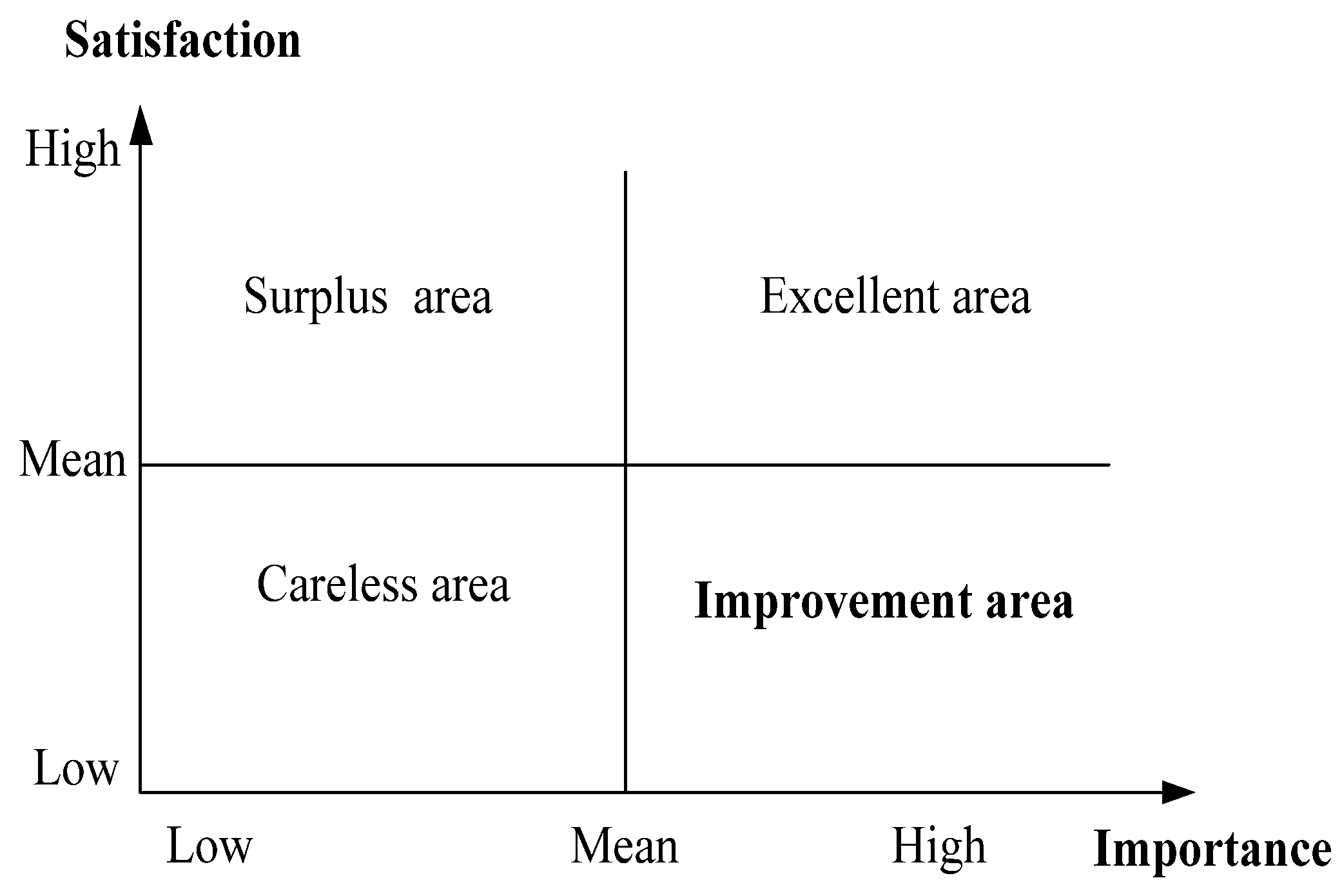
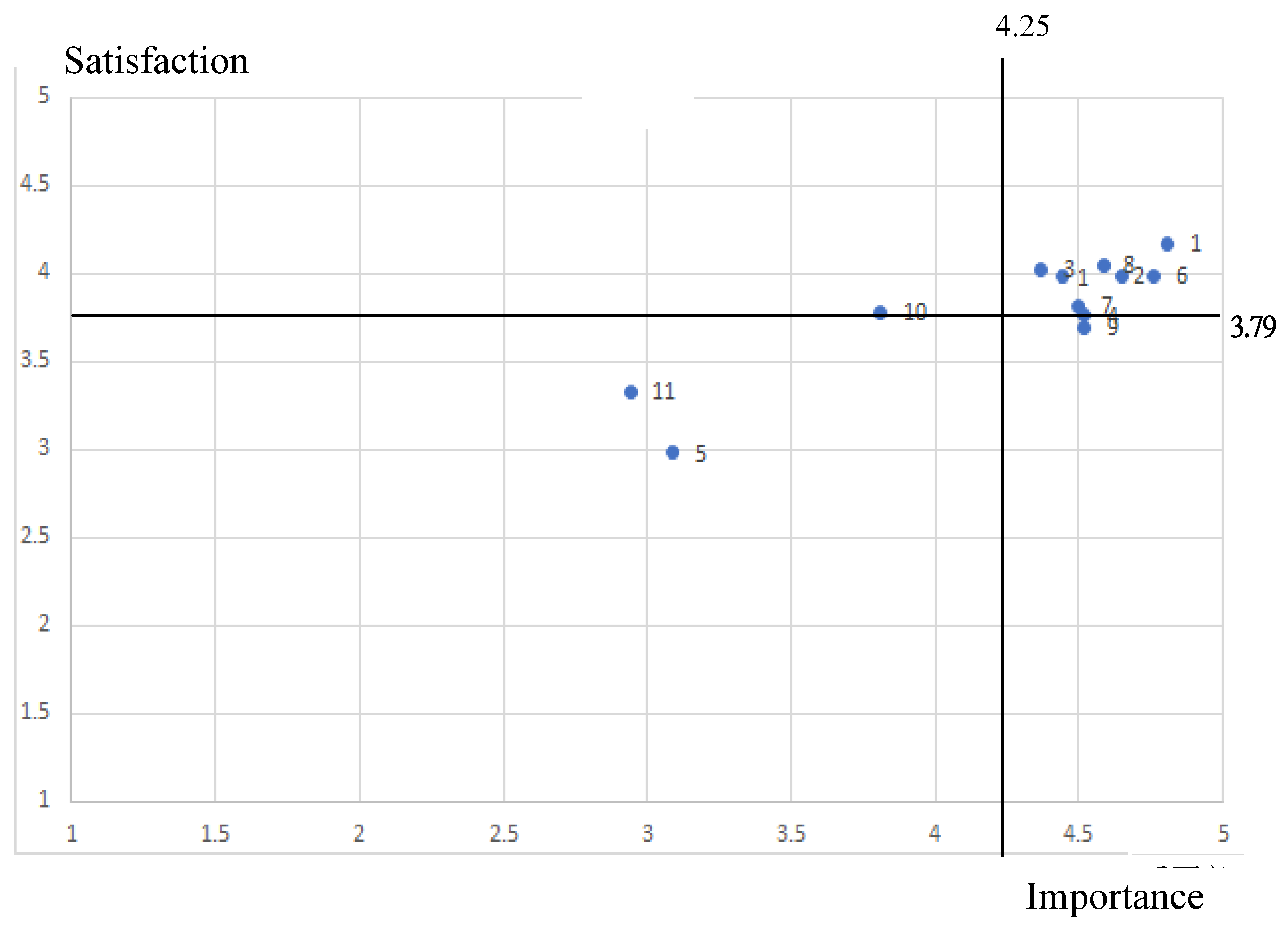
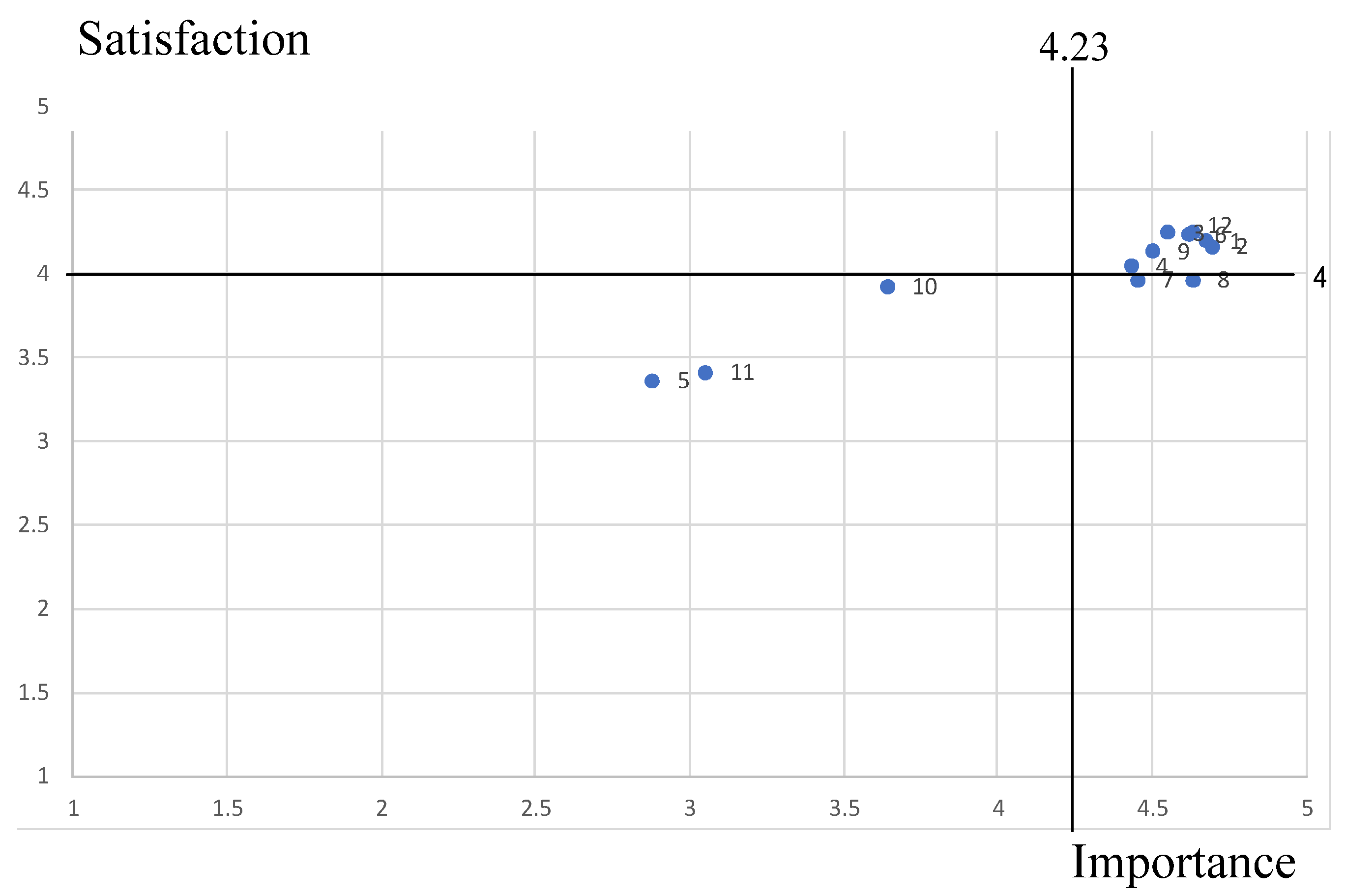
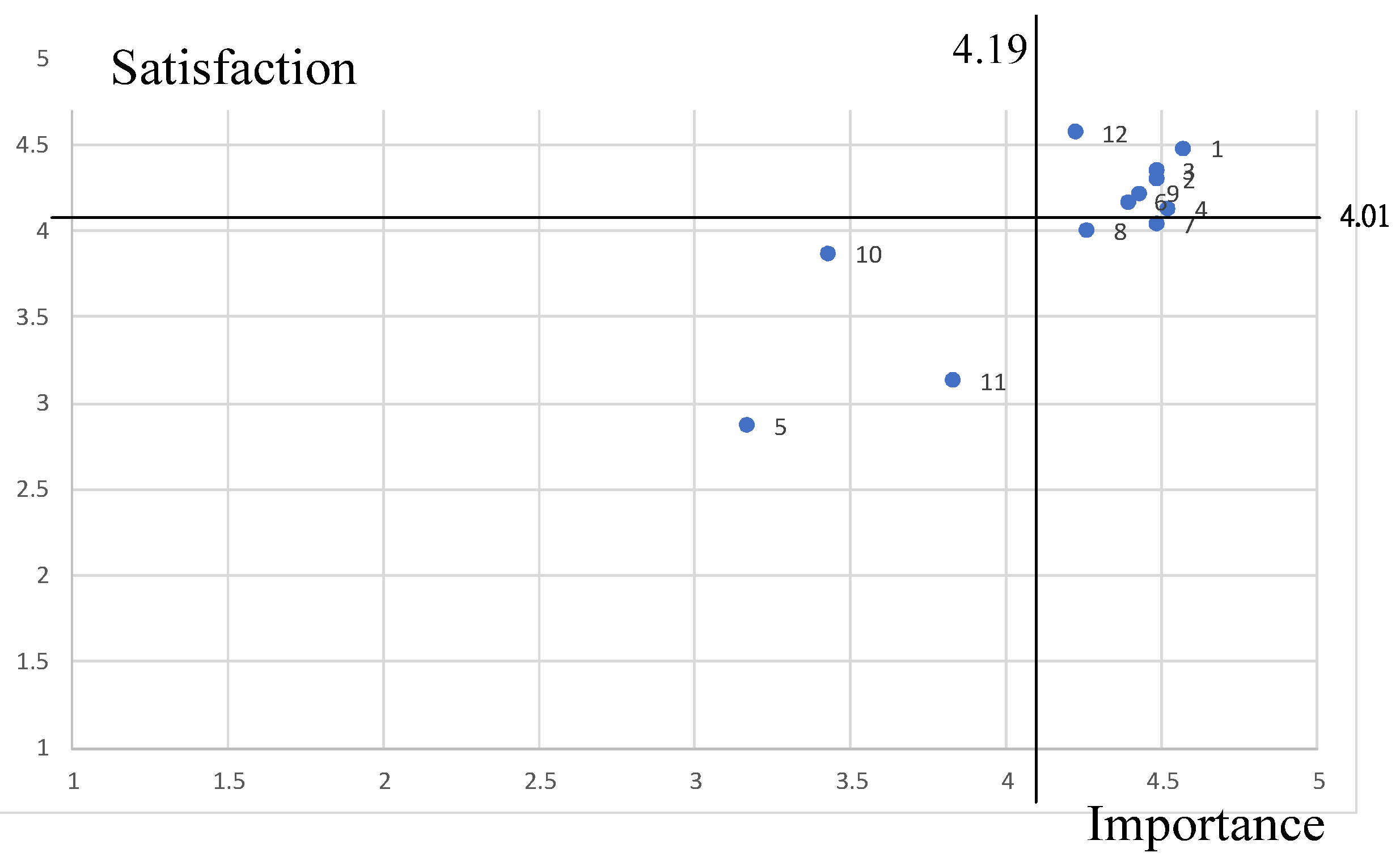
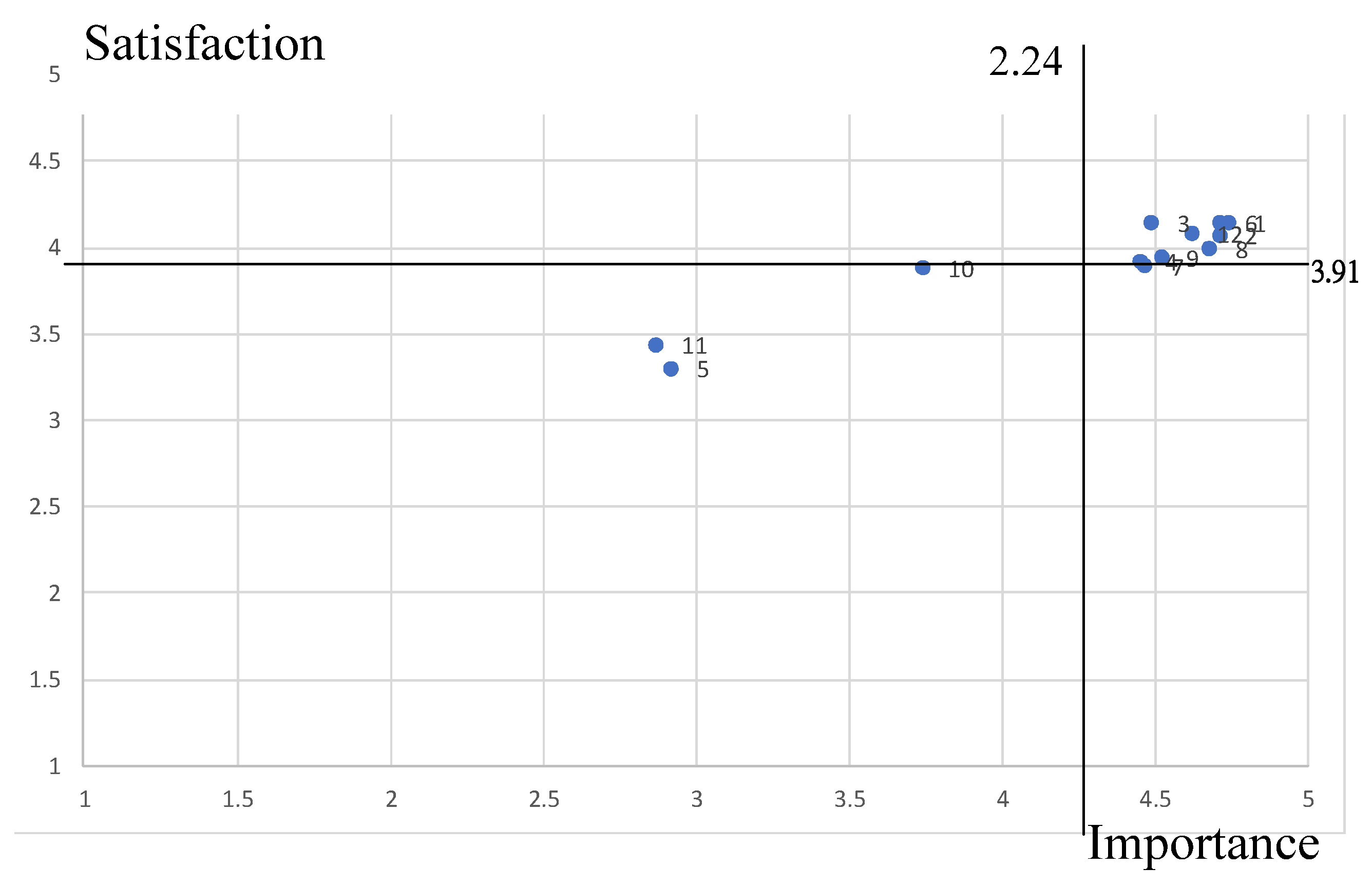
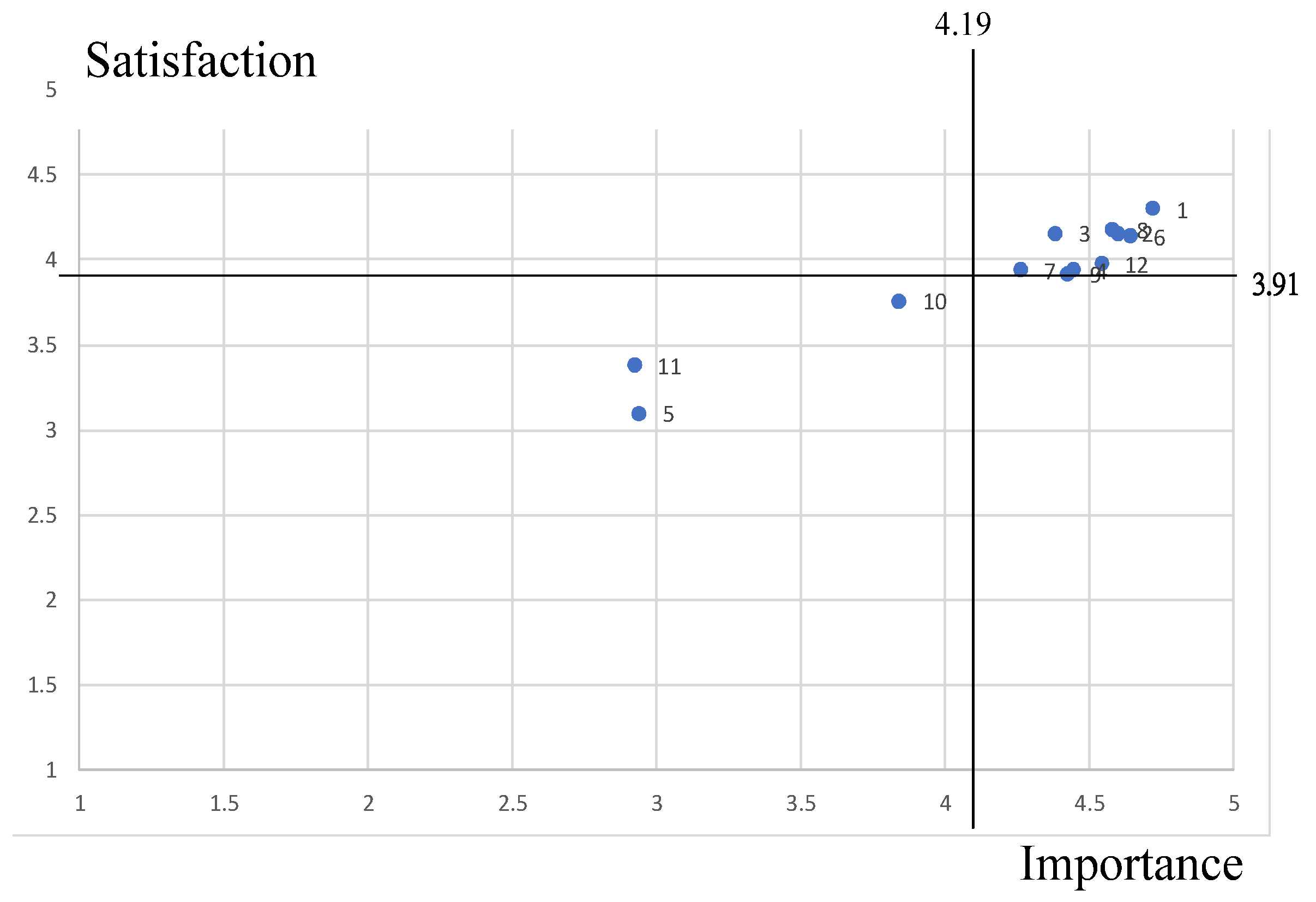
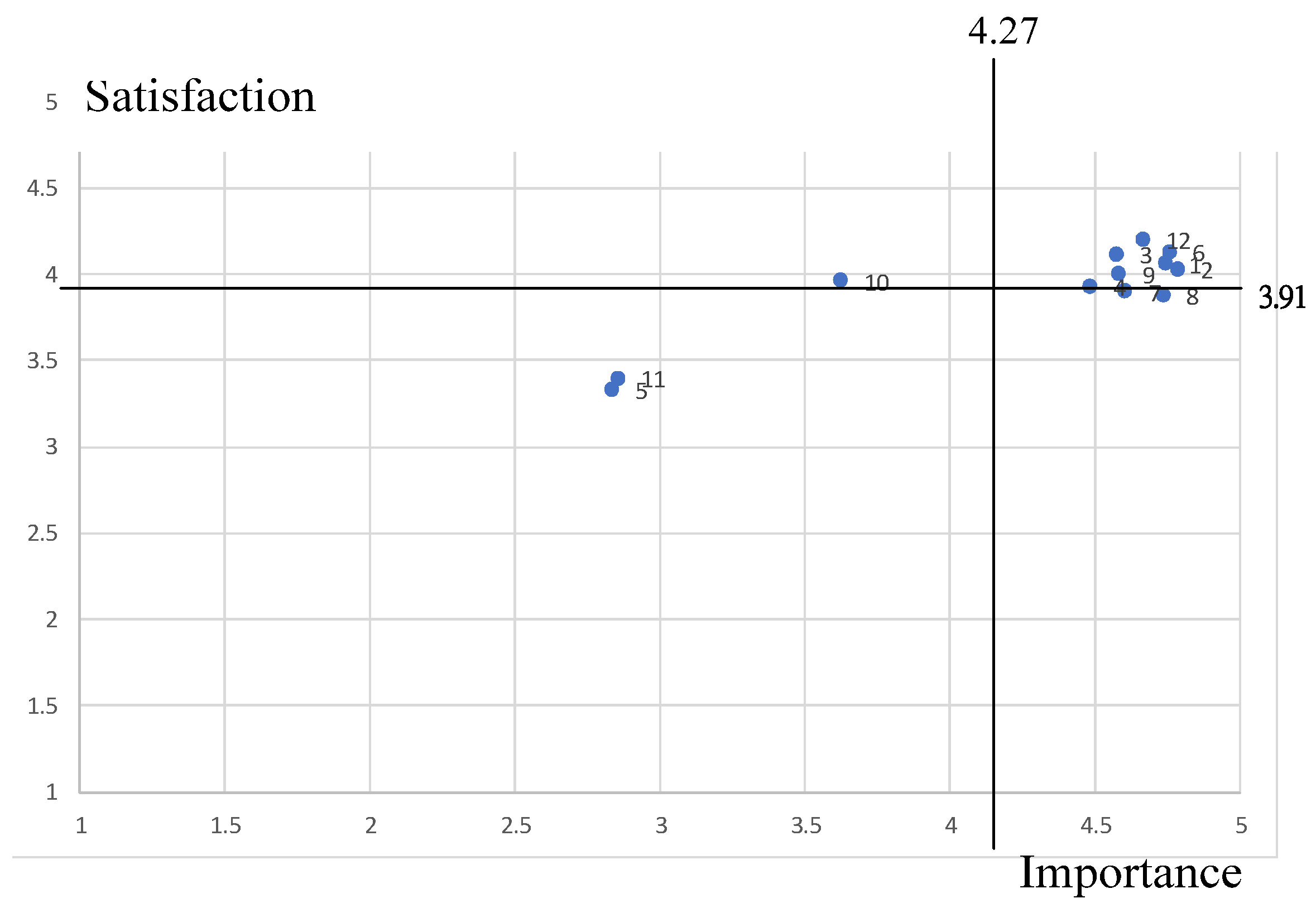
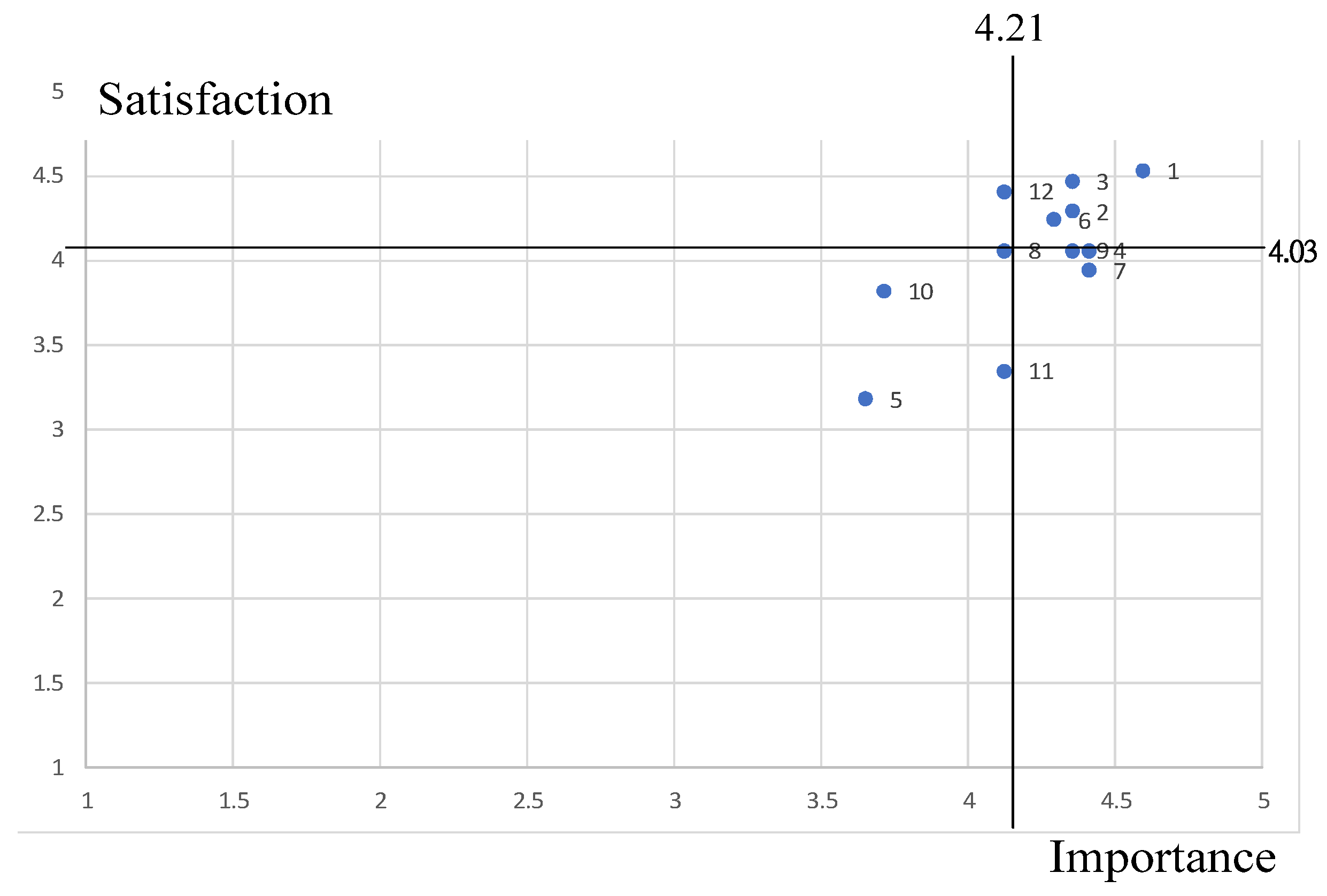
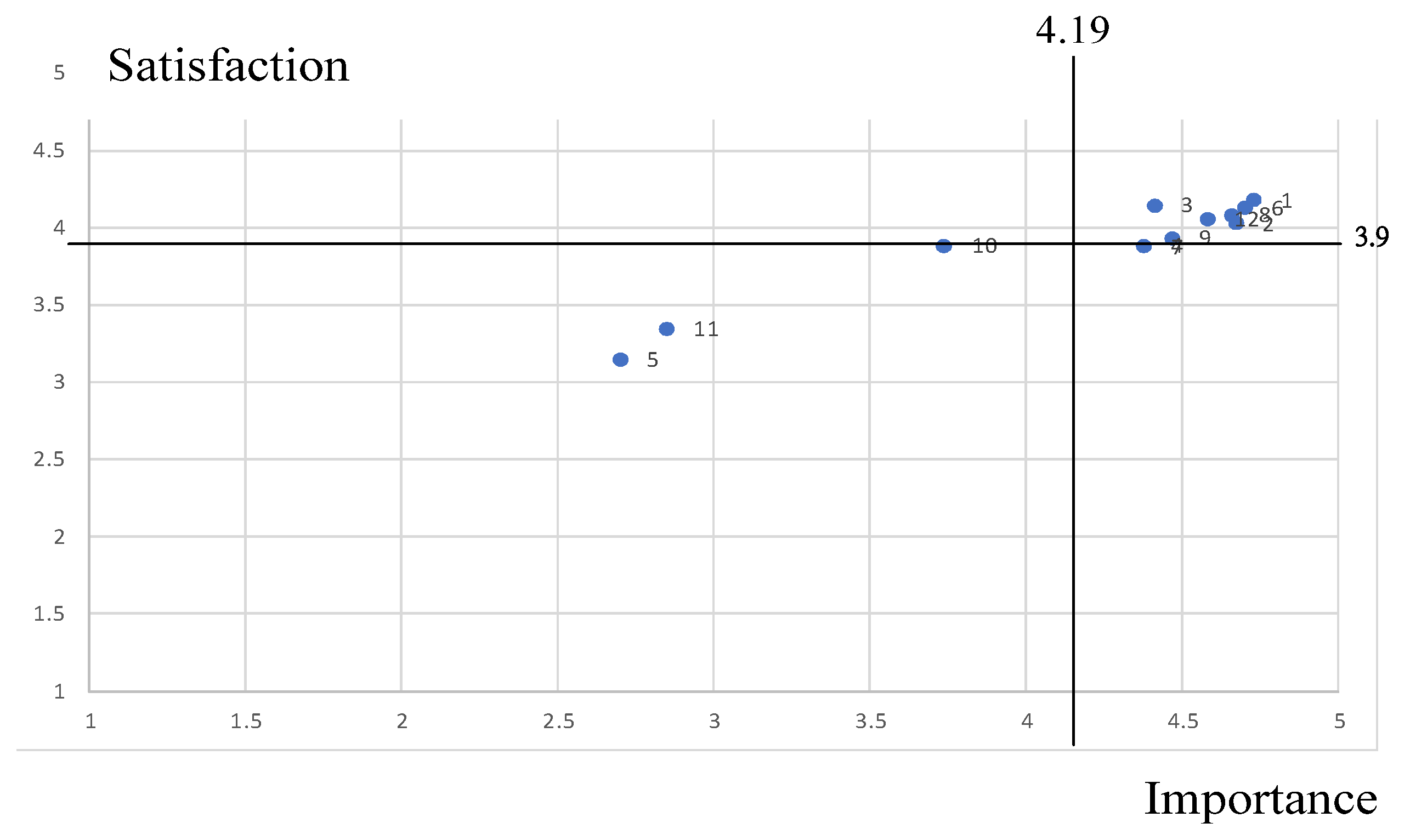
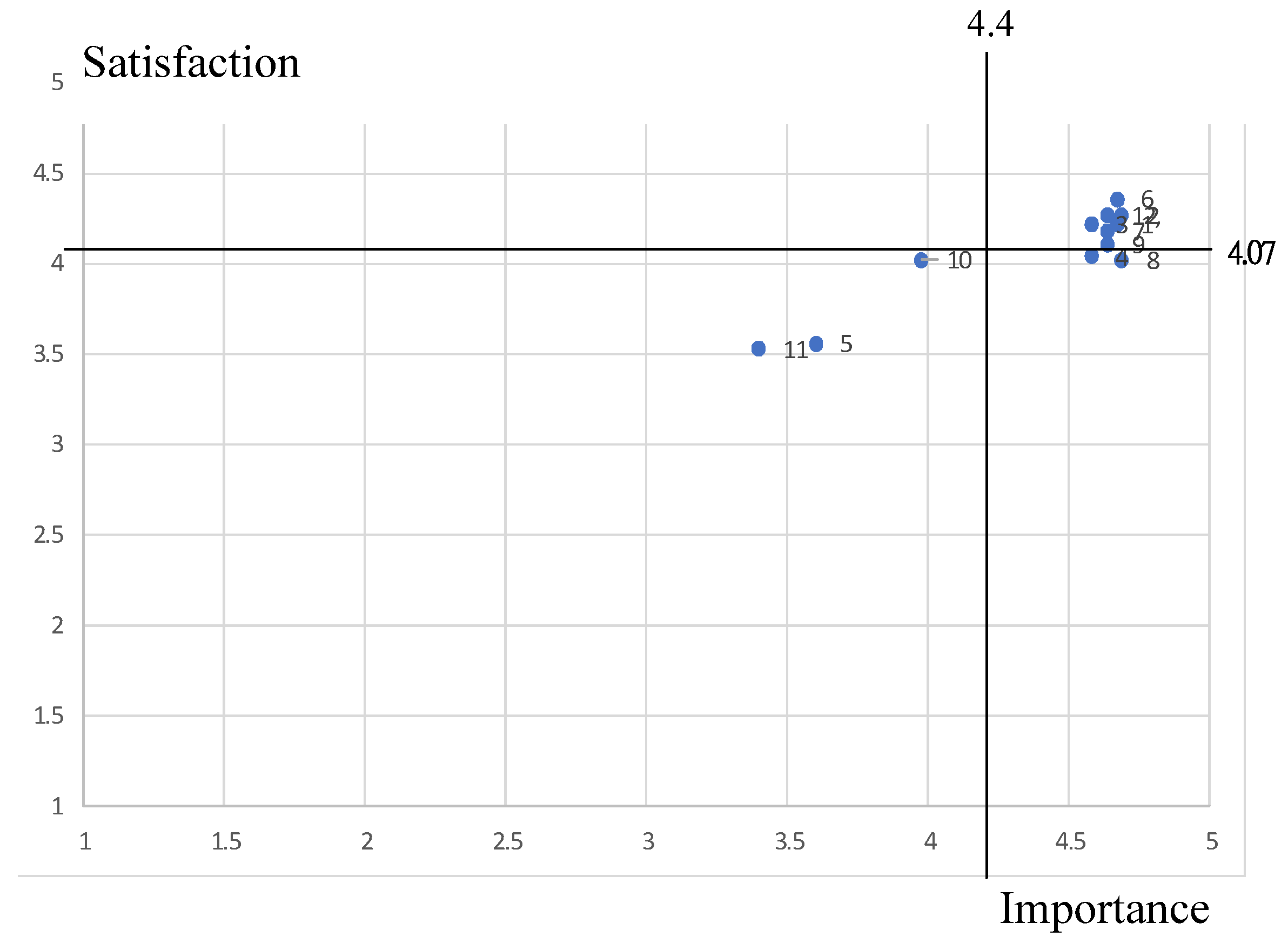
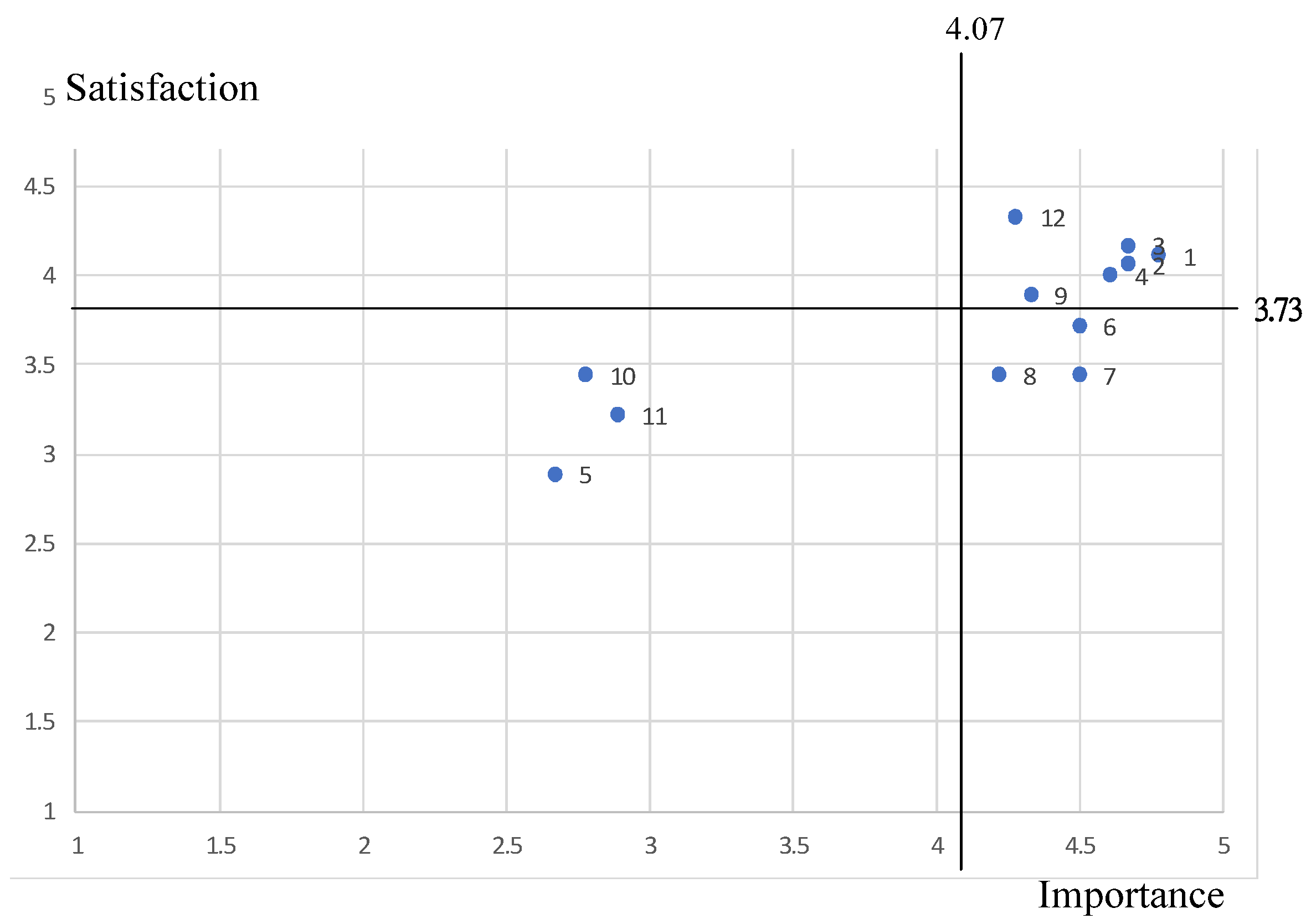
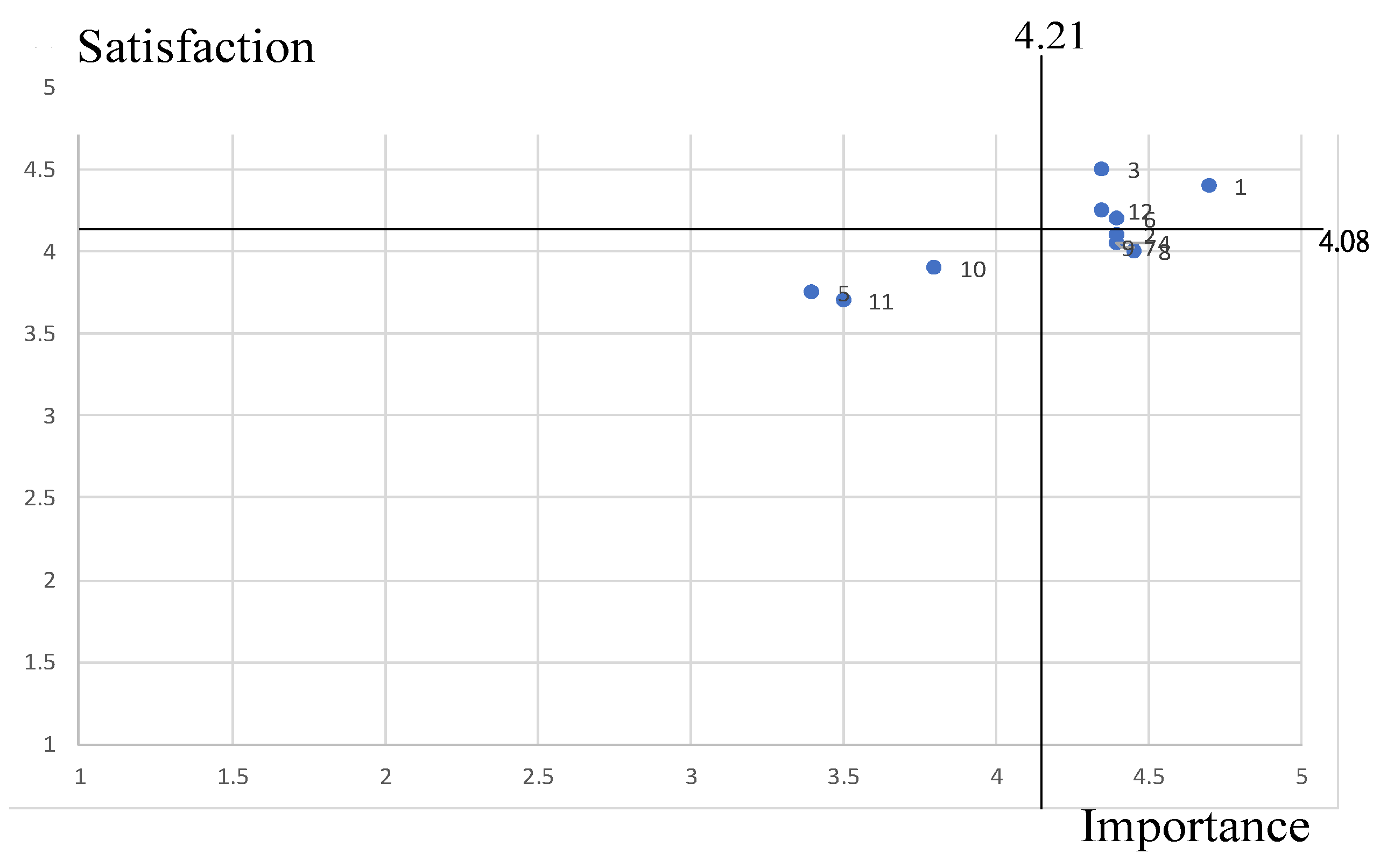
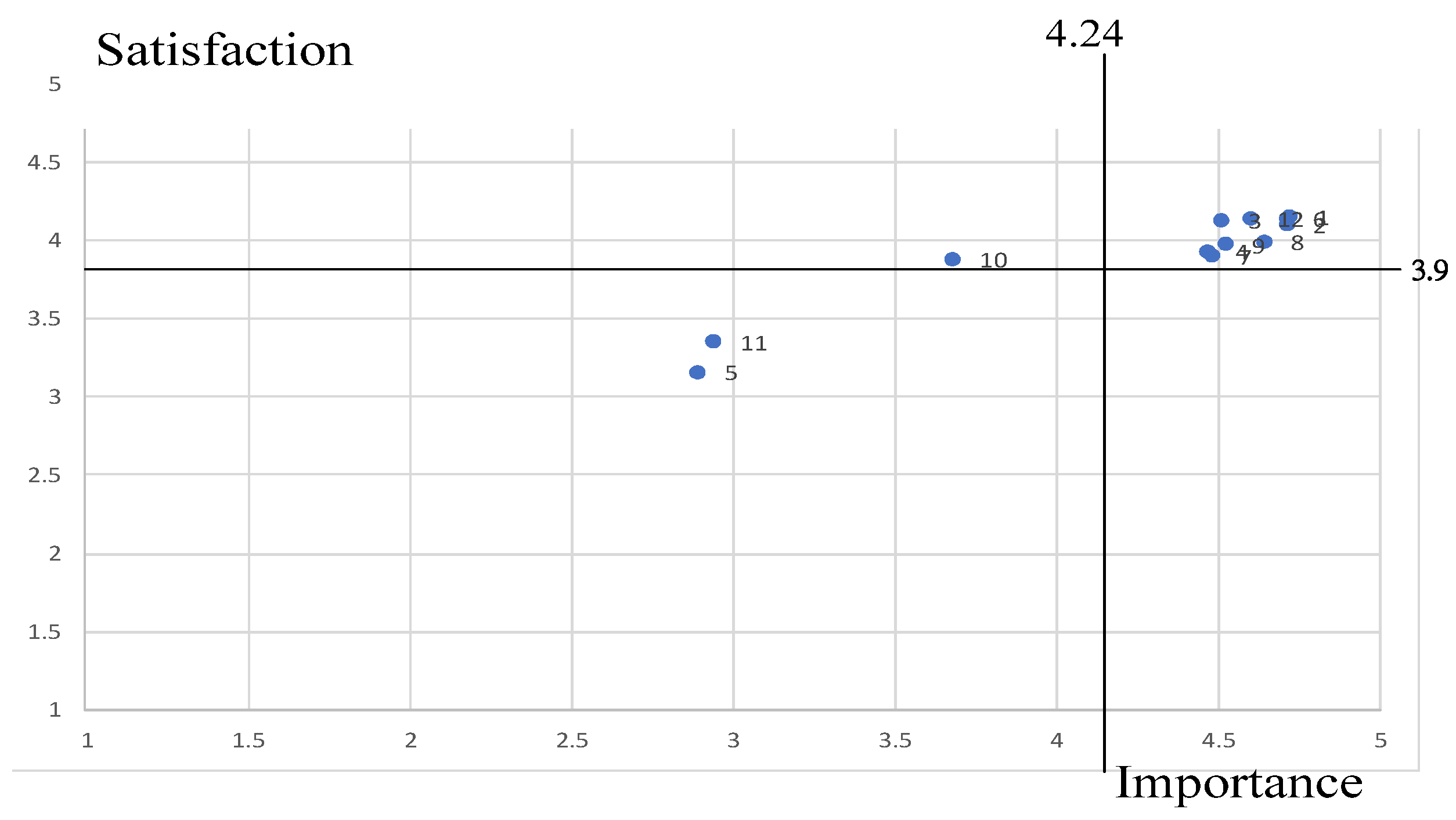
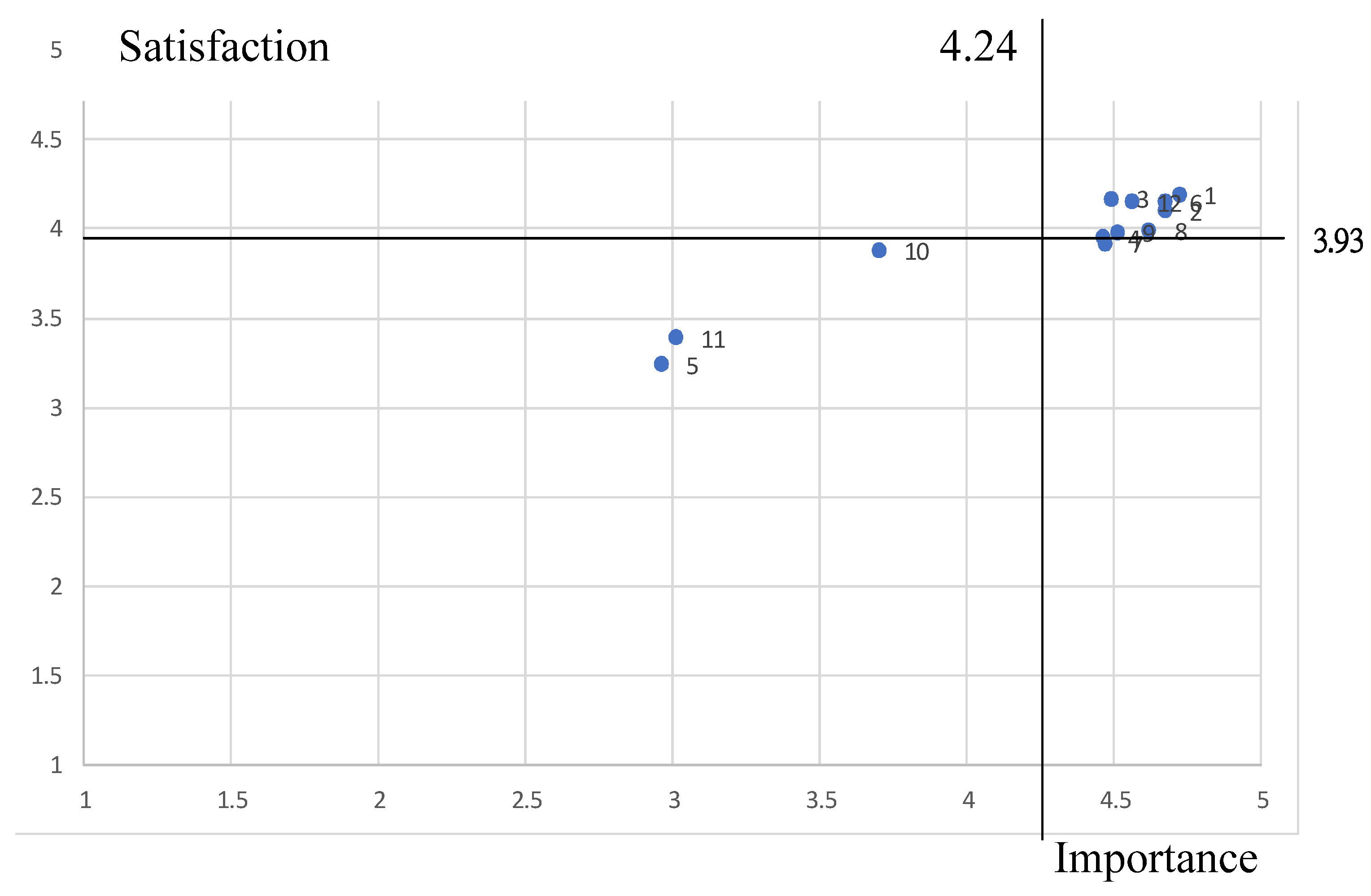
| Items | Demographic Factors | No | Percent |
|---|---|---|---|
| Gender | Male | 70 | 27.34% |
| Female | 186 | 72.66% | |
| Marital status | Married | 78 | 30.47% |
| Single | 178 | 69.53% | |
| Age | Below 20 | 91 | 35.55% |
| 21–30 | 102 | 39.84% | |
| 31–40 | 43 | 16.80% | |
| 41–50 | 11 | 4.30% | |
| Above 51 | 9 | 3.52% | |
| Occupation | Student | 125 | 48.83% |
| Government employees | 17 | 6.64% | |
| Service industry | 62 | 24.22% | |
| High-tech industry | 15 | 5.86% | |
| Agriculture industry | 18 | 7.03% | |
| Financial industry | 7 | 2.73% | |
| Others | 12 | 4.69% | |
| Education level | Below high school | 57 | 22.27% |
| College/University | 187 | 73.05% | |
| Graduate school | 12 | 4.69% | |
| Average usage rate/month | Fewer than 2 times | 59 | 23.5% |
| 3–6 times | 133 | 51.95% | |
| 7–9 times | 39 | 15.23% | |
| More than 10 times | 25 | 9.77% |
| Items | Demographic Factors | No |
|---|---|---|
| Gender | Male | 70 |
| Female | 186 | |
| Marital status | Married | 78 |
| Single | 178 | |
| Age | Below 20 | 91 |
| 21–30 | 102 | |
| Over 31 | 63 | |
| Occupation | Student | 125 |
| Service industry | 62 | |
| Others | 69 | |
| Education level | High school and lower | 57 |
| College/University and above | 199 |
| Items | Male | Female | ||||
|---|---|---|---|---|---|---|
| I | S | I–S Model | I | S | I–S Model | |
| 1 | 4.81 | 4.17 | Excellent | 4.67 | 4.20 | Excellent |
| 2 | 4.65 | 3.98 | Excellent | 4.69 | 4.17 | Excellent |
| 3 | 4.37 | 4.02 | Excellent | 4.55 | 4.25 | Excellent |
| 4 | 4.52 | 3.76 | Improvement | 4.43 | 4.05 | Improvement |
| 5 | 3.09 | 2.98 | Careless | 2.88 | 3.37 | Careless |
| 6 | 4.76 | 3.98 | Excellent | 4.62 | 4.24 | Excellent |
| 7 | 4.50 | 3.81 | Excellent | 4.45 | 3.97 | Improvement |
| 8 | 4.59 | 4.04 | Excellent | 4.63 | 3.97 | Improvement |
| 9 | 4.52 | 3.69 | Improvement | 4.50 | 4.14 | Excellent |
| 10 | 3.81 | 3.78 | Careless | 3.64 | 3.93 | Surplus |
| 11 | 2.94 | 3.33 | Careless | 3.05 | 3.42 | Careless |
| 12 | 4.44 | 3.98 | Excellent | 4.63 | 4.25 | Excellent |
| 4.25 | 3.79 | 4.23 | 4.00 | |||
| Items | Single | Married | ||||
|---|---|---|---|---|---|---|
| I | S | I–S Model | I | S | I–S Model | |
| 1 | 4.74 | 4.14 | Excellent | 4.57 | 4.48 | Excellent |
| 2 | 4.71 | 4.07 | Excellent | 4.48 | 4.30 | Excellent |
| 3 | 4.49 | 4.14 | Excellent | 4.48 | 4.35 | Excellent |
| 4 | 4.45 | 3.92 | Excellent | 4.52 | 4.13 | Excellent |
| 5 | 2.92 | 3.30 | Careless | 3.17 | 2.87 | Careless |
| 6 | 4.71 | 4.14 | Excellent | 4.39 | 4.17 | Excellent |
| 7 | 4.47 | 3.89 | Improvement | 4.48 | 4.04 | Excellent |
| 8 | 4.68 | 3.99 | Excellent | 4.26 | 4.00 | Improvement |
| 9 | 4.52 | 3.94 | Excellent | 4.43 | 4.22 | Excellent |
| 10 | 3.74 | 3.88 | Surplus | 3.43 | 3.87 | Surplus |
| 11 | 2.87 | 3.44 | Careless | 3.83 | 3.13 | Careless |
| 12 | 4.62 | 4.08 | Excellent | 4.22 | 4.57 | Excellent |
| 4.24 | 3.91 | 4.19 | 4.01 | |||
| Items | Below 20 | 21–30 | Over 31 | ||||||
|---|---|---|---|---|---|---|---|---|---|
| I | S | I–S Model | I | S | I–S Model | I | S | I–S Model | |
| 1 | 4.72 | 4.30 | Excellent | 4.74 | 4.06 | Excellent | 4.59 | 4.53 | Excellent |
| 2 | 4.60 | 4.16 | Excellent | 4.78 | 4.03 | Excellent | 4.35 | 4.29 | Excellent |
| 3 | 4.38 | 4.16 | Excellent | 4.57 | 4.12 | Excellent | 4.35 | 4.47 | Excellent |
| 4 | 4.44 | 3.94 | Excellent | 4.48 | 3.93 | Excellent | 4.41 | 4.06 | Excellent |
| 5 | 2.94 | 3.10 | Careless | 2.83 | 3.33 | Careless | 3.65 | 3.18 | Careless |
| 6 | 4.64 | 4.14 | Excellent | 4.75 | 4.13 | Excellent | 4.29 | 4.24 | Excellent |
| 7 | 4.26 | 3.94 | Excellent | 4.60 | 3.90 | Improvement | 4.41 | 3.94 | Improvement |
| 8 | 4.58 | 4.18 | Excellent | 4.73 | 3.88 | Improvement | 4.12 | 4.06 | Surplus |
| 9 | 4.42 | 3.92 | Excellent | 4.58 | 4.00 | Excellent | 4.35 | 4.06 | Excellent |
| 10 | 3.84 | 3.76 | Surplus | 3.62 | 3.96 | Surplus | 3.71 | 3.82 | Careless |
| 11 | 2.92 | 3.38 | Careless | 2.85 | 3.40 | Careless | 4.12 | 3.35 | Careless |
| 12 | 4.54 | 3.98 | Excellent | 4.66 | 4.20 | Excellent | 4.12 | 4.41 | Surplus |
| 4.19 | 3.91 | 4.27 | 3.91 | 4.21 | 4.03 | ||||
| Items | Student | Service Industry | Other Industry | ||||||
|---|---|---|---|---|---|---|---|---|---|
| I | S | I–S Model | I | S | I–S Model | I | S | I–S Model | |
| 1 | 4.73 | 4.18 | Excellent | 4.67 | 4.22 | Excellent | 4.78 | 4.11 | Excellent |
| 2 | 4.67 | 4.03 | Excellent | 4.69 | 4.27 | Excellent | 4.67 | 4.06 | Excellent |
| 3 | 4.41 | 4.15 | Excellent | 4.58 | 4.22 | Excellent | 4.67 | 4.17 | Excellent |
| 4 | 4.38 | 3.89 | Improvement | 4.58 | 4.04 | Improvement | 4.61 | 4.00 | Excellent |
| 5 | 2.70 | 3.15 | Careless | 3.60 | 3.56 | Careless | 2.67 | 2.89 | Careless |
| 6 | 4.70 | 4.13 | Excellent | 4.67 | 4.36 | Excellent | 4.50 | 3.72 | Improvement |
| 7 | 4.38 | 3.88 | Improvement | 4.64 | 4.18 | Excellent | 4.50 | 3.44 | Improvement |
| 8 | 4.66 | 4.09 | Excellent | 4.69 | 4.02 | Careless | 4.22 | 3.44 | Improvement |
| 9 | 4.47 | 3.94 | Excellent | 4.64 | 4.11 | Excellent | 4.33 | 3.89 | Improvement |
| 10 | 3.74 | 3.89 | Careless | 3.98 | 4.02 | Careless | 2.78 | 3.44 | Careless |
| 11 | 2.85 | 3.35 | Careless | 3.40 | 3.53 | Careless | 2.89 | 3.22 | Careless |
| 12 | 4.58 | 4.06 | Excellent | 4.64 | 4.27 | Excellent | 4.28 | 4.33 | Excellent |
| 4.19 | 3.90 | 4.40 | 4.07 | 4.07 | 3.73 | ||||
| Items | Below High School | College/University | ||||
|---|---|---|---|---|---|---|
| I | S | I–S Model | I | S | I–S Model | |
| 1 | 4.70 | 4.40 | Excellent | 4.72 | 4.15 | Excellent |
| 2 | 4.40 | 4.10 | Excellent | 4.71 | 4.10 | Excellent |
| 3 | 4.35 | 4.50 | Excellent | 4.51 | 4.13 | Excellent |
| 4 | 4.40 | 4.05 | Improvement | 4.47 | 3.93 | Excellent |
| 5 | 3.40 | 3.75 | Careless | 2.89 | 3.16 | Careless |
| 6 | 4.40 | 4.20 | Excellent | 4.71 | 4.14 | Excellent |
| 7 | 4.40 | 4.05 | Improvement | 4.48 | 3.90 | Excellent |
| 8 | 4.45 | 4.00 | Improvement | 4.64 | 3.99 | Excellent |
| 9 | 4.40 | 4.05 | Improvement | 4.52 | 3.97 | Excellent |
| 10 | 3.80 | 3.90 | Careless | 3.68 | 3.88 | Careless |
| 11 | 3.50 | 3.70 | Careless | 2.94 | 3.35 | Careless |
| 12 | 4.35 | 4.25 | Excellent | 4.60 | 4.14 | Excellent |
| 4.21 | 4.08 | 4.24 | 3.90 | |||
| Items | I | S | I–S Model |
|---|---|---|---|
| 1 Number of vendors | 4.72 | 4.19 | Excellent |
| 2 Food style | 4.67 | 4.10 | Excellent |
| 3 Service attitude of the delivery staff | 4.49 | 4.17 | Excellent |
| 4 Delivery speed | 4.46 | 3.95 | Excellent |
| 5 Appearance of the delivery staff | 2.96 | 3.24 | Careless |
| 6 Freshness of food | 4.67 | 4.15 | Excellent |
| 7 Food price | 4.47 | 3.92 | Improvement |
| 8 User-friendliness of the app | 4.62 | 3.99 | Excellent |
| 9 Delivery price | 4.51 | 3.98 | Excellent |
| 10 Popularity of the vendor | 3.70 | 3.88 | Careless |
| 11 Celebrity endorsement | 3.01 | 3.39 | Careless |
| 12 Sales promotions | 4.56 | 4.15 | Excellent |
| 4.24 | 3.93 |
Publisher’s Note: MDPI stays neutral with regard to jurisdictional claims in published maps and institutional affiliations. |
© 2021 by the authors. Licensee MDPI, Basel, Switzerland. This article is an open access article distributed under the terms and conditions of the Creative Commons Attribution (CC BY) license (https://creativecommons.org/licenses/by/4.0/).
Share and Cite
Liu, Y.-Y.; Chen, S.-H.; Zhang, J.-X. Applying Importance–Satisfaction Model to Evaluate Customer Satisfaction: An Empirical Study of Foodpanda. Sustainability 2021, 13, 10985. https://doi.org/10.3390/su131910985
Liu Y-Y, Chen S-H, Zhang J-X. Applying Importance–Satisfaction Model to Evaluate Customer Satisfaction: An Empirical Study of Foodpanda. Sustainability. 2021; 13(19):10985. https://doi.org/10.3390/su131910985
Chicago/Turabian StyleLiu, Yi-Yuan, Shun-Hsing Chen, and Jia-Xuan Zhang. 2021. "Applying Importance–Satisfaction Model to Evaluate Customer Satisfaction: An Empirical Study of Foodpanda" Sustainability 13, no. 19: 10985. https://doi.org/10.3390/su131910985
APA StyleLiu, Y.-Y., Chen, S.-H., & Zhang, J.-X. (2021). Applying Importance–Satisfaction Model to Evaluate Customer Satisfaction: An Empirical Study of Foodpanda. Sustainability, 13(19), 10985. https://doi.org/10.3390/su131910985






